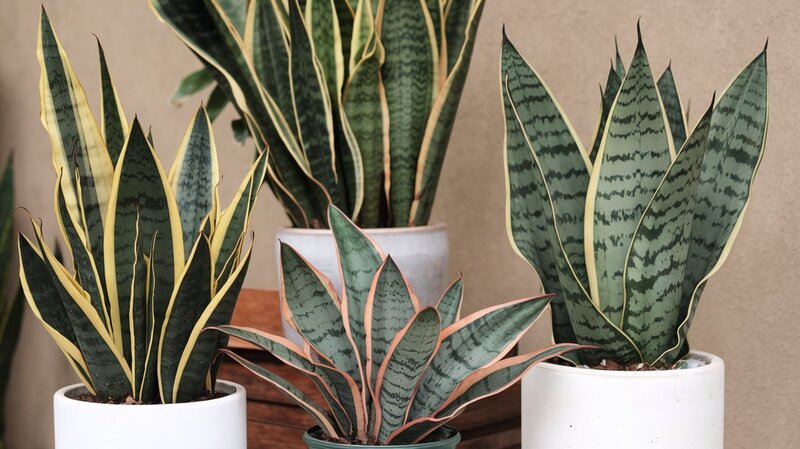
Sansevieria is a wonderful plant, also referred to as Mother-in-Law Tongue or Snake Plant. Originally from Africa, Sansevieria arrived in Europe around the eighteenth century.
Dracaena trifasciata is the scientific name for this specific sansevieria. Its sword-shaped leaves are sculpturally beautiful and require very little maintenance. I have snake plants in almost every area of my house, and they really liven up the space!
Benefits of Keeping Snake Plants in Your Home
Look no farther than the snake plant if you're looking for a low-maintenance, superstar air purifier to add to your collection! There are so many advantages to this hardy cookie that you'll want to snake-proof your entire house. The advantages of owning a snake plant in your house are as follows:
· Air filtration
Sansevieriatrifasciata, often known as snake plants, is well renowned for its capacity to eliminate airborne toxins and pollutants, including xylene, benzene, and formaldehyde. They are an excellent option for your interior areas since they work especially well in low light.
· Little upkeep
Snake plants are well-known for their capacity to withstand drought and low water levels. Generally speaking, it's preferable to let the soil totally dry out in between waterings. This might occur once every two to eight weeks, depending on the circumstances in your house. It's crucial to remember that throughout the winter, when they are not actively developing, snake plants need less water!

· Benefits for health
Numerous health advantages of snake plants have been discovered, including a reduction in headaches, eye discomfort, and respiratory issues. They have also been demonstrated to increase productivity and focus.
· Beauty
Snake plants are a popular option for home décor because of their sleek, contemporary look, which goes well with many other types of design. We particularly enjoy it when you design a Sanseveria plant wall! If you want to split areas, it looks amazing and works well as a wall divider.
· Feng Shui
Snake plants are thought to bring good fortune and positive energy into a location, according to fengshui! To encourage good chi flow, they are frequently positioned in corners of rooms or next to entrances.
Because it can withstand a variety of growing situations, snake plants are an excellent option for novices. When placed inside, this low-maintenance container plant provides visual intrigue.
How to care Snake Plants

· The light
Eight to ten hours of indirect sunshine or a few hours of early morning full sunlight are ideal for snake plant growth. A plant that receives too much direct sunlight risks burnt leaves. While some shadow is OK for snake plants, too little light will hinder development and dilute the plant's color.
· Soil
Since snake plants are houseplants, they do best in a loose, well-drained potting soil mixture. All-purpose cactus potting soil is an excellent option because they thrive in sandier soil. Steer clear of soil mixes with a lot of peat since they may hold too much water.
· Water
When the earth is fully dry, give your snake plant a thorough watering. In the winter, check the soil mix every two weeks or so; the plant may only require monthly watering. Water right away if you see that the leaves are dry and brittle.
Remember that the easiest way to destroy a snake plant is to overwater it. The plant's root system will decay if it receives excessive water or is left in the water. An early warning indicator of overwatering is yellowing foliage.
· Humidity and Temperature
The ideal growing temperature range for snake plants is between 70°F and 90°F. Plants should not be exposed to chilly drafts.
Frost will not harm them, yet extended exposure to temperatures below 50°F can cause the plant to die. Humidity levels in the typical home between thirty and fifty percent will be acceptable for them.
· Apply fertilizer
Feed your snake plant once in the spring and once in the middle of summer using a half-strength, balanced, slow-releasing 10-10-10 fertilizer. Fertilize nothing in the winter.
Snake Plant Varieties

· Dracaena trifasciata 'Hahnii',
also known as the bird's nest snake plant, reaches a height of only six inches.
· Dracaena angolensi:
is a cylindrical snake plant with stiff, rounded leaves that extend several feet from a central crown.
· Dracaena trifasciata 'Laurentii':
The edges of the leaves of this variegated cultivar have a creamy golden color.
· 'Twisted Sister',
Dracaena trifasciatathe plant's leaves are twisted, with yellow-variegated margins and horizontal patterns. It has a height of 15 inches.
· Dracaena trifasciata, 'Bantel’s Sensation':
This three-foot-tall cultivar has slender leaves with white vertical stripes.
· Dracaena pearsonii:
Also known as rhino grass, this plant reaches a height of 12 inches and has succulent leaves with a crimson color.
Common Problems and How to Fix Them
1. Growing Yellow Leaves
A common problem, yellowing leaves can be brought on by overwatering, inadequate sunlight, or a lack of nutrients.
Resolution:
· Flooding: Because they can withstand dryness, snake plants want their soil to get dry in between watering. Reduce the frequency of watering to remedy this. Make sure there is adequate drainage in the pot to avoid water collecting at the bottom.
· Lighting: Although they may survive in low light, snake plants prefer bright, indirect light. Shift your plant to a brighter spot, but keep it out of direct sunlight since it might burn the leaves.
· Nutrient Deficiency: During the growing season (spring and summer), if the plant is not receiving enough nutrients, think about using a balanced, all-purpose houseplant fertilizer once a month.
2. Root Rot
Overwatering and improper drainage can result in damp soil and rotting roots, which is the main cause of root rot.
Resolution:
· Watering: Let the soil completely dry out in between applications. Give the plant regular, deep watering.
· Drainage: Use well-draining soil, such as a cactus or succulent mix, and make sure the pot has drainage holes. To enhance drainage, you may also amend the soil with sand or perlite.
· Treatment: Take the plant out of its pot, cut out any rotted roots, and repot it in dry, new soil if you think it may have root rot.
3. Brown Points
The accumulation of salt in the soil, infrequent watering, or low humidity can all cause brown tips on the leaves of snake plants.
Resolution:
· Watering Keep a regular watering schedule and make sure the soil dries out somewhat between applications, but not excessively.
· Humidity: While snake plants may survive in dry conditions, very low humidity might result in brown tips. Use a humidifier or sometimes wet the leaves to increase humidity.
· Salt Buildup: Excessive fertilization or tap water can also lead to salt buildup. To remove extra salt from the soil, run water through the pot for a few minutes.

4. Sagging Foliage
Dropping leaves are frequently an indication of inadequate lighting, overwatering, or underwatering.
Resolution:
· Flooding: If the soil seems persistently damp, check its moisture content and cut back on watering. Make sure the drainage is adequate.
· Underwatering: Give the plant good irrigation if the soil is very dry. Make sure to water your plants on a regular basis.
· Lighting: Make sure there is adequate light reaching the plant. If it's in dim light, move it to a brighter area.
5. Pests
Although snake plants are generally pest-resistant, sometimes they may get infested with mealybugs, aphids, or spider mites.
Resolution:
· Spider mites are the culprit behind the stippling and webbing on leaves. Use a moist towel to wipe the leaves of the plant and treat it with seem oil or insecticidal soap.
· Mealybugs: These pests resemble cottony, whitish masses. Use a cotton swab dipped in rubbing alcohol to remove them, and then apply insecticidal soap to the plant.
· Aphids: Water can be sprayed to eliminate these tiny, green insects. For infestations that are more severe, use insecticidal soap.
6. Curling leaves
Pests, temperature stress, and inadequate irrigation can all lead to curling leaves.
Resolution:
· Watering: Make sure you're giving the plant enough water. Leaf curling may result from either overwatering or underwatering.
· Temperature: Prevent abrupt temperature swings and cold breezes by keeping the plant in a steady environment.
· Pests: Look for indications of pest activity on the plant and treat as needed.
Sources
https://abeautifulmess.com/how-to-care-for-snake-plants/
https://www.leafenvy.co.uk/blogs/plant-care-tips/top-5-benefits-of-having-a-snake-plant-in-your-home
https://www.healthline.com/health/benefits-of-snake-plant
https://www.thespruce.com/snake-plant-care-overview-1902772
https://tuigarden.co.nz/how-to-guide/snake-plant-care-guide/
https://plantaddicts.com/common-snake-plant-problems/
https://growhub.ae/blogs/blog/common-problems-with-snake-plants-and-how-to-fix-them

